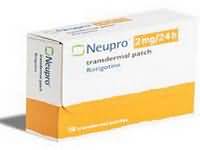CLINICAL USE
Treatment of Parkinson’s disease
DOSE IN NORMAL RENAL FUNCTION
2–8 mg every 24 hours With levodopa: max 16 mg every 24 hours
PHARMACOKINETICS
DOSE IN RENAL IMPAIRMENT
GFR (mL/MIN)
DOSE IN PATIENTS UNDERGOING RENAL REPLACEMENT THERAPIES
IMPORTANT DRUG INTERACTIONS
Potentially hazardous interactions with other drugs
ADMINISTRATION
Reconstition
–
Route
Topical
Rate of Administration
–
Comments
–
OTHER INFORMATION
Discontinue gradually at a rate of 2 mg/24 hours, every other day
Apply to intact skin on the abdomen, thigh, hip, flank, shoulder or upper armIf a patch falls off replace with a new one Backing layer contains aluminium and should be removed prior to MRIs or cardioversionRotigotine is being investigated for its use in restless legs syndrome.

